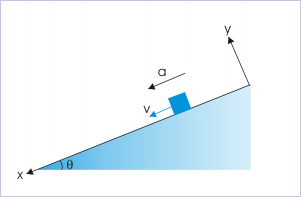| << Chapter < Page | Chapter >> Page > |
Problem : The coordinates of a particle (m/s) in a plane at a given time “t” is . Find (i) path of motion (ii) velocity at time “t” and (iii) acceleration at time “t”.
Solution : Clearly, the position of the particle is a function of time and the particle moves in a two dimensional xy - plane. Here,
In order to find the relation between “x” and “y”, we substitute “t” from the first equation in to second as :
Hence, path of motion is parabolic. Now, the position vector is :
Differentiating with respect to time, the velocity of the particle is :
Further differentiating with respect to time, the acceleration of the particle is :
Problem : At a certain instant, the components of velocity and acceleration are given as :
What is the rate of change of speed?
Solution : Here, phrasing of question is important. We are required to find the rate of change of speed – not the rate of change of velocity or magnitude of rate of change of velocity. Let us have a look at the subtle differences in the meaning here :
1: The rate of change of velocity
The rate of change of velocity is equal to acceleration. For the given two dimensional motion,
2: The magnitude of rate of change of velocity
The magnitude of rate of change of velocity is equal to magnitude of acceleration. For the given two dimensional motion,
3: The rate of change of speed
The rate of change of speed (dv/dt) is not equal to the magnitude of acceleration, which is equal to the absolute value of the rate of change of velocity. It is so because speed is devoid of direction, whereas acceleration consists of both magnitude and direction.
Let “v” be the instantaneous speed, which is given in terms of its component as :
We need to find rate of change of speed i.e dv/dt, using the values given in the question. Therefore, we need to differentiate speed with respect to time,
If we ponder a bit, then we would realize that when we deal with component speed or magnitude of component velocity then we are essentially dealing with unidirectional motion. No change in direction is possible as components are aligned to a fixed axis. As such, equating rate of change in speed with the magnitude of acceleration in component direction is valid. Now, proceeding ahead,
Putting values, we have :
Note: This is an important question as it brings out differences in interpretation of familiar terms. In order to emphasize the difference, we summarize the discussion as hereunder :
i: In general (i.e two or three dimensions),
ii: In the case of one dimensional motion, the inequality as above disappears.
Problem : A block is released from rest on a smooth inclined plane. If denotes the distance traveled by it from t = n - 1 second to t = n seconds, then find the ratio :
Motion along an incline

Solution : It must be noted that the description of linear motion is governed by the equations of motion whether particle moves on a horizontal surface (one dimensional description) or on an inclined surface (two dimensional description). Let us orient our coordinates so that the motion can be treated as one dimensional unidirectional motion. This allows us to use equations of motion in scalar form,
Here, u = 0, thus
Following the description of term Sn as given by the question, we can define Sn+1 as the linear distance from t = n second to t = n + 1 seconds. Thus, substituting “n” by “n+1” in the formulae, we have :
The required ratio is :
Problem : A force of 2 N is applied on a particle of mass 1 kg, which is moving with a velocity 4 m/s in a perpendicular direction. If the force is applied all through the motion, then find displacement and velocity after 2 seconds.
Solution : It is a two dimensional motion, but having a constant acceleration. Notably, velocity and accelerations are not in the same direction. In order to find the displacement at the end of 2 seconds, we shall use algebraic method. Let the direction of initial velocity and acceleration be along “x” and “y” coordinates (they are perpendicular to each other). Also, let “A” be the initial position and “B” be the final position of the particle. The displacement between A (position at time t =0) and B (position at time t = 2 s) is given as :
For time t = 2 s,
This is a vector equation involving sum of two vectors at right angles. According to question,
Since u and a perpendicular to each other, the magnitude of the vector sum ( u + a ) is :
Hence, magnitude of displacement is :
Let the displacement vector makes an angle “θ” with the direction of initial velocity.
Let the direction of initial velocity and acceleration be along “x” and “y” coordinates (they are perpendicular to each other). Then,
Using equation of motion for constant acceleration, the final velocity is :
The magnitude of velocity is :
Let the final velocity vector makes an angle “θ” with the direction of initial velocity.

Notification Switch
Would you like to follow the 'Physics for k-12' conversation and receive update notifications?